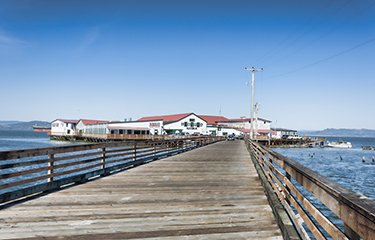West Coast fishing communities’ vulnerability to climate change assessed in new study

Climate change is warping the West Coast marine ecosystem. Warm waters are driving species north. Acidification and deoxygenation are threatening coastal species.
Fishermen are intimately familiar with these impacts. When the marine heat wave of 2014 and 2015 – dubbed "the Blob" – raised water temperatures for months on end, fishermen saw landing revenues of salmon and hake drop. That heat wave foreshadowed the increased and more severe heat waves that are likely to come.
Despite mounting evidence of the imminent biological impacts of climate change on the West Coast marine ecosystem, it's unknown how well fishermen will be able to adapt – and if the coastal communities in which they live will be able to ride out the changes.
A new research project, led by scientists at the University of Washington and funded by the Lenfest Ocean Program, seeks to assess which West Coast communities are most vulnerable to the transformations climate change will cause in fisheries, including albacore tuna, salmon, shrimp, crab, squid, and many groundfish species.
"If Dungeness crab goes away as a fishery, what happens to those people [fishing it]?" project lead Phil Levin, who is a University of Washington professor and the lead scientist for The Nature Conservancy's Washington office, told SeafoodSource. "Do they have ways to weather storms? Do they have financial resources? How is their community? Do they have alternate jobs?"
In general, smaller coastal fishing communities will be impacted much more than large cities such as Seattle. Even though a huge amount of seafood moves through Seattle, because much of the Alaska fleet operates from there, the city itself will be more resilient to climate change impacts.
"If fisheries went away, Seattle is still here. Whereas, if you're Astoria or Newport, Oregon, or lots of other places on the coast, you're really dependent on fishing," Levin said.
In general, both individual fisherman and entire communities that tap into more diverse fish portfolios are more resilient to change, Levin said. But regulations tend to promote consolidation and specialization.
The study will use existing fisheries data from the National Oceanic and Atmospheric Administration, plus census data for 250 communities. In addition, the study will examine how fishermen perceive risk, to see if their perceptions match empirical calculations of risk. The researchers are surveying fishermen with commercial licenses, as well as conducting in-depth interviews with key stakeholders and managers.
Fishermen are intimately familiar with the water and the species on which they depend, so their perception of the effects and risks of climate change will likely differ from the data.
"How people act ultimately depends on their perception, which may or may not be informed by scientific assessment,” Levin said. "In some sense, I think their perception of what's going on both on what species are changing and the spatial scale, and how they can adapt, we think that will be more informative in some ways.”
Frustration forms when a person feels like they can't control their own future. Even if fishermen are making money, they might discourage their children from entering the fishing business because of perceived risk – and sell out to a large corporation instead. Uncertainty about ocean conditions could play into the perceived risk, too.
"And now the environment is unpredictable and uncertain and they have no control over it, so now their agency is declining," Levin said. "You're making business decisions based on the feeling that you're getting regulated out of existence or climate change is making it impossible to run an effective business. So those are feelings that affect business decisions.”
Levin has done similar analyses of wildfires in California and natural disasters such as Hurricane Katrina, assessing biological sensitivity, the level of exposure of human communities, and the potential ability of communities to bounce back. The same analysis could be done for the impact of oil spills or hypoxia – deoxygenation of the water – or even offshore energy installations.
"How is that going to affect the fishing grounds and which communities are going to be more or less impacted by that?" Levin said
As fishermen adapt to a changing reality on the seas, society has a few levers it can pull, both market-based and management, to help them, Levin said.
"If you have a species that's expanding northward and you have no capacity to process that species and there's just not the shore-side infrastructure to deal with that species, that's a species that's going to go unharvested, when it could potentially be sustainably harvested," Levin said. "People are going to fish, so rather than fish a species that is declining because of climate, rather than overharvesting, maybe you can focus on a species that is expanding rather than a declining one"
The project’s empirical analysis will be done and surveys collected by the end of April, though it could take a year or more to analyze the data and issue final results. Additional analyses are being considered for other regions, such as New England and the Gulf of Mexico, Levin said.
Photo courtesy of Dee Browning/Shutterstock






Share